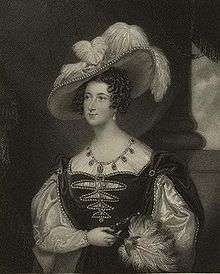Anna Russell, Duchess of Bedford
Anna Maria Russell, Duchess of Bedford (3 September 1783 – 3 July 1857)[1] was a lifelong friend of Queen Victoria,[2] whom she served as a Lady of the Bedchamber between 1837 and 1841.[3] She was also the originator of the British meal "afternoon tea."[4]
The Duchess of Bedford | |
|---|---|
 Anna Russell, Duchess of Bedford | |
| Born | Anna Maria Stanhope 3 September 1783 |
| Died | 3 July 1857 (aged 73) |
| Burial place | Bedford chapel, Chenies, Buckinghamshire |
| Spouse(s) | |
| Children | William Russell, 8th Duke of Bedford |
| Parent(s) | Charles Stanhope, 3rd Earl of Harrington Jane Fleming |
Anna was the daughter of Charles Stanhope, 3rd Earl of Harrington, and Jane Fleming. She was the wife of Francis Russell, 7th Duke of Bedford (married in 1808), and sister-in-law to the Prime Minister John Russell. She was also the mother of William Russell, 8th Duke of Bedford. She became Duchess of Bedford in 1839, when her husband acceded to the dukedom.
The Duchess and her husband entertained the Queen at their country house Woburn Abbey in 1841. The Duchess was also the chief mourner at the funeral of The Princess Augusta Sophia in 1840.
Scandal
The Duchess became involved in a scandal regarding Lady Flora Hastings. When Lady Flora complained of abdominal pain, the court physician initially stated that she was pregnant. As Lady Flora was unmarried this suspicion was covered up, but the Duchess and Baroness Lehzen who disliked her spread the rumour anyway, naming Sir John Conroy as the likely father. When she was later diagnosed with cancer of which she died shortly afterward, the Duchess, Baroness Lehzen and the Queen herself, who had initially believed the rumour, came under severe public criticism for blemishing the reputation of an innocent woman.
Afternoon tea
The Duchess is best remembered as the creator of afternoon tea whilst visiting the 5th Duke of Rutland at Belvoir Castle in the mid-1840s. During the 18th century, dinner came to be served later and later in the day until, by the early 19th century, the normal time was between 7:00 and 8:30 p.m. An extra meal called luncheon had been created to fill the midday gap between breakfast and dinner, but as this new meal was very light, the long afternoon with no refreshment at all left people feeling hungry. She found a light meal of tea (usually Darjeeling) and cakes or sandwiches to be the perfect balance. The Duchess found taking an afternoon snack to be such a perfect refreshment that she soon began inviting her friends to join her. Afternoon tea quickly became an established and convivial repast in many upper middle and upper class households.
Death
She died in 1857 and is buried in the Bedford chapel at Chenies in Buckinghamshire.
References
- Lodge, Edmund (1861). The Peerage and Baronetage of the British Empire (30th ed.). London: Hurst and Blackett. p. 54 at Google Books.
- Bedford, Duke of. The History and Treasures of Woburn Abbey. Pitkin Pictorials; p. 11
- The peerage. The Hon. Anna Maria Stanhope
- Tavistock, Marquess of. Woburn Abbey. 1995. Woburn Abbey and Jarrold Publishing